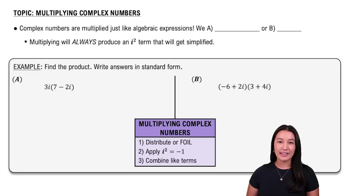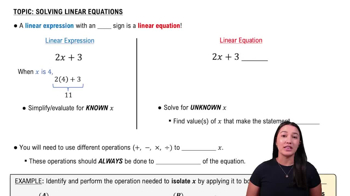Table of contents
- 0. Review of College Algebra4h 43m
- 1. Measuring Angles39m
- 2. Trigonometric Functions on Right Triangles2h 5m
- 3. Unit Circle1h 19m
- 4. Graphing Trigonometric Functions1h 19m
- 5. Inverse Trigonometric Functions and Basic Trigonometric Equations1h 41m
- 6. Trigonometric Identities and More Equations2h 34m
- 7. Non-Right Triangles1h 38m
- 8. Vectors2h 25m
- 9. Polar Equations2h 5m
- 10. Parametric Equations1h 6m
- 11. Graphing Complex Numbers1h 7m
0. Review of College Algebra
Solving Linear Equations
Problem 23b
Textbook Question
Find each sum or difference. See Example 1. -6 - 5
 Verified step by step guidance
Verified step by step guidance1
Identify the operation: This problem involves subtraction, specifically finding the difference between two numbers.
Recognize the numbers involved: The numbers are -6 and 5.
Apply the rule for subtracting a positive number from a negative number: When you subtract a positive number from a negative number, you move further left on the number line.
Rewrite the expression: Subtracting a positive number is the same as adding its negative, so -6 - 5 can be rewritten as -6 + (-5).
Combine the numbers: Add the two negative numbers together by combining their absolute values and keeping the negative sign.
Recommended similar problem, with video answer:
 Verified Solution
Verified SolutionThis video solution was recommended by our tutors as helpful for the problem above
Video duration:
1mPlay a video:
Was this helpful?
Key Concepts
Here are the essential concepts you must grasp in order to answer the question correctly.
Basic Arithmetic Operations
Understanding basic arithmetic operations, such as addition and subtraction, is essential for solving mathematical expressions. In this case, the operation involves subtracting two integers, which requires knowledge of how to handle negative numbers and the rules governing their addition and subtraction.
Recommended video:

Algebraic Operations on Vectors
Negative Numbers
Negative numbers are numbers less than zero and are crucial in arithmetic operations involving subtraction. When subtracting a larger negative number from a smaller one, the result can be counterintuitive, as it may lead to a more negative outcome. Recognizing how to manipulate negative values is key to solving the problem correctly.
Recommended video:

Multiplying Complex Numbers
Order of Operations
The order of operations is a set of rules that dictates the sequence in which different mathematical operations should be performed to ensure consistent results. Although this specific question involves only subtraction, understanding the order of operations is vital in more complex expressions where multiple operations are present.
Recommended video:

Algebraic Operations on Vectors

 7:48m
7:48mWatch next
Master Solving Linear Equations with a bite sized video explanation from Callie Rethman
Start learning



